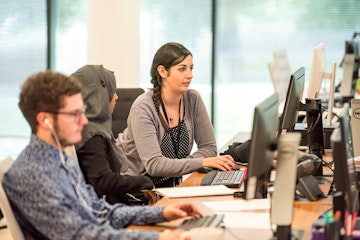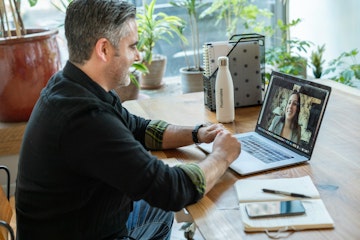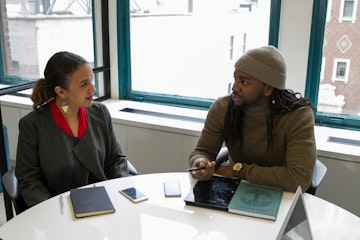Instructor Spotlight
How Meade Delivers Job-Relevant UX Design Training at BrainStation Miami

![]()
Written By Jess Feldman

![]()
Written By Jess Feldman
Course Report strives to create the most trust-worthy content about coding bootcamps. Read more about Course Report’s Editorial Policy and How We Make Money.
Course Report strives to create the most trust-worthy content about coding bootcamps. Read more about Course Report’s Editorial Policy and How We Make Money.
Want to know who may be teaching you UX design at BrainStation Miami? Meet Meade McCoy, a passionate instructor who left the world of Product Design to train the next generation of UX designers in Florida. Meade tells us what makes BrainStation’s Miami campus a unique and creative space for students, what you can expect from the UX Design bootcamp’s job-relevant curriculum, and 17 different job titles that you could land after graduating. Plus, why learning about user accessibility is crucial in 2022.
How did you get started in UX design, Meade?
I have a diverse background, ranging from hospitality management to nonprofit work to UX design. The constant throughout my career has always been my interest in training, development, and maximizing efficiency. I have a master’s degree in human performance improvement, which combines training and development with organizational analysis and change aspects. When I was in hospitality, I focused on the analysis, design, and implementation of training programs. In the non-profit sector, I was involved in a little bit of everything, including designing websites, which ended up being my entry point to tech! I then got into complex form design, which used design to simplify forms to obtain immense amounts of information without overwhelming the user.
After I left the non-profit industry I considered going back into performance improvement and training design, but I wanted something more creative. I researched UX design bootcamps in Miami and chose Wyncode Academy, which is now BrainStation. Now as a UX designer, I’m fulfilling a childhood dream of being an “efficiency expert”. There's a lot of overlap between what I consider to be an efficiency expert and what I do in UX, which is making the world a more efficient place. It’s cool that it came full circle.
What motivated you to return to BrainStation to teach UX design?
I love to teach! I've always ended up in a training position in every role I've had. I love to inspire other people, introduce them to new ideas, and see how they run with them. I loved my time at Wyncode and the opportunities it provided me. When BrainStation reached out to me to see if I would be interested in teaching, I jumped for joy!
What makes BrainStation’s Miami campus so unique?
Miami is a unique place to begin with and we have an energy you won't find anywhere else. The BrainStation campus is located in Wynwood, a former warehousing district that's becoming an art and cultural center and also a microcosm of the throws of change and development happening in Miami. Wynwood is home to Wynwood Walls, full of murals both intentional and spontaneous. The funky, artistic vibe is vibrant and inspiring. It's one of those places where inspiration is around every corner. The BrainStation Miami campus is a great place to be a bootcamp student.
Is Miami a good place to launch a UX design career?
Miami is in the throes of a tech boom and it still feels like the beginning stages. It’s an exciting time to evolve in tech! I am a huge fan of innovation, how it works, and how that clash of ideas leads to amazing new developments. When you have many people working on different things in the same physical environment, those ideas can clash and turn out some really fun, incredibly creative, very futuristic developments. That's what Miami feels like right now.
It has an interesting combination of emerging startups and established companies. Both have their advantages and disadvantages; working in startups can be challenging, especially as a new UX designer, but it presents a phenomenal opportunity to get experience in all aspects of UX. On the other hand, having more companies headquartered in Miami offers a different opportunity for new UX designers to dive into an existing team and work with specialized UX professionals, such as designers, architects, and UX researchers. Miami provides a wide spectrum of environments and types of products to work on, which is fantastic if you're new to UX design because you get to pick how you want to continue to learn.
What does the UX design bootcamp curriculum cover at BrainStation?
Our curriculum at BrainStation is about creating a whole UX designer. It’s important to understand that by signing up for the UX design bootcamp, you are signing up for a lot very quickly. Students learn all aspects of what this career entails, from research to design, including content, interaction, UI design. This gives our graduates a strong set of marketable skills that can carry them into a variety of design roles. Graduates are primed for startups because they have an all-encompassing perspective of UX.
In terms of the technologies that the curriculum covers, we start with a pen/pencil/marker and paper. You've got to master that first, which seems weird for a tech career. Then we move on to other relevant technology for the field, such us InVision and Figma. Once students master Figma, they can easily switch into using Sketch, Adobe XD, or other prominent wireframing tools. We also cover digital whiteboarding, which has become a prominent tool and skill since many people now work-from-home. It's not the same to work on a digital whiteboard as it is a physical whiteboard, but since our students are working with the digital version from the start, they are primed for online remote working.
Students can choose to specialize while at the bootcamp. Some fall in love with research and become UX researchers, while others love UI design and focus their careers in that direction. We teach students the skills they need to follow their passions into a career.
In your experience in the tech industry, why do you think those are the most relevant technologies for bootcamp students to learn?
One of the things I love about teaching at BrainStation is that the program is continuously being updated. We're UX designers, so we can not leave something alone! We will always find a way to improve it. We carry this mindset into our educational program at BrainStation. As the technology marketplace moves, we move with it.
What kinds of projects do your students work on?
Students will work on a variety of projects over the course of the UX Design bootcamp. In my current cohort, we’re in a UI week, learning about color and typography. Since they have hit week 8 of this 12-week program, they are largely focused on their capstone project, which is the culmination of everything that they've learned in the bootcamp. For their capstone, they’re designing individual applications. They came up with the ideas, they did all the research behind it, and they're currently in mid-fidelity prototyping. Then they’ll go through high-fidelity and eventually turn it into a portfolio case study. Finally, they’ll present their capstone to industry experts at a demo day!
Do you recommend that UX design students also learn front-end development?
Having knowledge of front-end development can be very useful if someone chooses to be end-to-end and do all the design work and code, but coding is not a requirement for UX design. I took a development course so that I could know some code and communicate with the developers I work with more efficiently.
In your time at BrainStation as a student and an instructor, have you found there’s an ideal student for the UX Design bootcamp?
There's not an ideal student, but the students that do well are the ones that have a passion for UX design, beyond wanting to make the lucrative entry-level salary that accompanies UX design. UX design is all about solving a problem and keeping that problem in mind the whole time.
I've seen people from varied backgrounds excel in this program. Some useful and interesting backgrounds that are students come from include:
What kinds of design jobs is the UX Design bootcamp preparing students for?
BrainStation’s UX Design bootcamp prepares students for a variety of career paths, from design to management. Students are prepared to apply for job titles, such as:
UX design is an entry into the tech field and you can go beyond that. The career possibilities are constantly expanding.
You were working as a Product Designer at Lowe’s – What kinds of projects were you working on?
At Lowe’s, I was designing internal financial software applications for employees to make pricing decisions. My job was to help increase efficiency and reduce errors for employees, by considering the information architecture and interaction design to find ways to make it intuitive, aid, and speed up their workflow. It was fascinating work that I loved doing — I just happen to love teaching more!
Is there any difference between a product designer and a UX designer?
There often is a difference between these roles but sometimes it's semantics, depending on the company and region. There can and should be a difference. Typically, product designers are not only concerned with their users, but also the needs of the business. Their design is client-focused and business-aware of both the current and future development. Product designers need to be able to think about the potential growth and direction of a changing business.
When you were working in UX design at Lowe’s, were you still using everything that you learned at BrainStation on the job?
Definitely. BrainStation opened the door for me and truly enabled me to do my job. I noticed my new colleagues entering the field alongside me with degrees in human computer interaction had taken a few disconnected UX classes but they didn’t have the experience of a three-month intensive like me. My experience of being taught such a specific skill set in such a condensed amount of time gave me a major advantage on the job. I came out of the bootcamp with a complete understanding of the whole process, end-to-end. At work, I was confused when people complained about tight deadlines because the deadlines and workload in a bootcamp are so intense that everything in comparison feels like a breeze!
How does BrainStation support women in tech?
At BrainStation, there has been a conscious emphasis on increasing the number of women working in tech, specifically at our Miami campus. I’m proud to say that BrainStation Miami staff is 80% women at the moment — that high of a margin is phenomenal! We actively seek out prospective students to diversify the tech landscape in Miami by connecting with organizations and foundations that are committed to increasing access to this type of education, such as universities and government agencies.
What is your advice for women new to the design field? Do you have any favorite meetups or organizations?
My advice is to find a community. Women are still a minority in the tech industry, which makes it imperative to build a strong community to support each other through what’s happening in our current workplaces and the industry in general. Bootcamps are a great place to form a tight knit community with your fellow students because you're in the trenches together. The next step is to maintain those connections. Get support from educators and other bootcamp staff and maintain those relationships into your career. Then go seek a broader community beyond your bootcamp! There are tech meetups in the Miami area as the market continues to grow. South Florida UX hosts a Slack channel called FluxYeah. It was started by a woman getting into UX in Miami and is now a huge and vibrant UX community online.
BrainStation also offers a number of events that can give you the chance to connect with current students, alumni, hiring partners, and industry leaders, including info sessions, Intro Days, and panel discussions.
Which resources or meetups do you recommend for complete beginners who want to start their design career in Miami?
There are a few resources in Miami that would introduce new UX designers to other professionals and passionate people in the area:
You’re passionate about user accessibility in tech – how are BrainStation students learning more about user accessibility during the bootcamp?
BrainStation already has a robust accessibility component to their curriculum that is continually being reiterated. In fact, we are updating that module again soon and I’m excited to contribute my passion and insight into its redesign. As an instructor, accessibility is deeply woven into every aspect of my teaching. All aspects of UX design can and should be influenced by accessibility. If we apply accessibility principles in all aspects of UX, we are creating universal design that is better for everyone.
I personally have profound dyslexia, ADHD, and auditory processing disorder, so I depend on accessible aides in what I do. Sometimes it's as basic as using Grammarly to check my spelling and grammar, but it goes way beyond that. My own experience is one of the reasons I care so passionately about it, but it certainly goes beyond my needs, which are pretty minor in comparison to how else we can improve accessibility. We have to consider that 20% of the world is considered disabled and at any time anyone can become partially disabled, through an accident, injury, or something as simple as a new mom holding a baby who now only has one hand with which to operate her devices. As our world becomes more digitally-centric and dependent on the internet and the things we build on it, we need to think about who and how users are able to participate.
Do you see the UX design as a solid career path in 2022?
Yes. As we have shifted to a digital world, it has become imperative for industries to evolve with the needs of their customers, from banking and government upkeep to entertainment and grocery shopping. The recent pandemic illuminated the potential of using the digital landscape to meet the needs of users in a more affordable way than in-person, considering the cost of infrastructure and staffing. The expansion of tools and their availability to us online and on our devices made up for what we can’t do in-person.
Companies run the risk of losing their customer base if they don’t evolve their digital presence to meet the needs of their users. As companies transfer their businesses into the digital landscape, they require skilled UX designers to create a user experience that is intuitive, clear, and easy.
Find out more and read BrainStation reviews on Course Report. This article was produced by the Course Report team in partnership with BrainStation.

Jess Feldman, Content Manager at Course Report
Jess Feldman is an accomplished writer and the Content Manager at Course Report, the leading platform for career changers who are exploring coding bootcamps. With a background in writing, teaching, and social media management, Jess plays a pivotal role in helping Course Report readers make informed decisions about their educational journey.










Sign up for our newsletter and receive our free guide to paying for a bootcamp.
Just tell us who you are and what you’re searching for, we’ll handle the rest.
Match Me